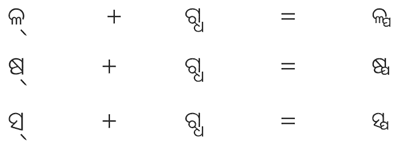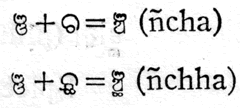- Previous message: jameskass@att.net: "RE: Complex Combining"
- Messages sorted by: [ date ] [ thread ] [ subject ] [ author ] [ attachment ]
- Mail actions: [ respond to this message ] [ mail a new topic ]
On pages 56 -57 of the TDIL newsletter from April 2002
(http://tdil.mit.gov.in/ori-guru-telu.pdf), there are various conjuncts
listed that are unusual in that the shapes that make up the conjunct are
quite different from the nominal characters that supposedly underlie the
conjunct and from the pronunciation.
Relevant portions from that newsletter are provided in the attached
files, Oriya_unusual_conjuncts_1.png to Oriya_unusual_conjuncts_4.png.
These show the conjunct and the underlying nominal characters underlying
each conjunct. That source doesn't give indication of the pronunciation,
but that the nominal character sequences described matches pronunciation
is shown for at least two of the conjuncts by samples from the book
"Oriya Self-Taught", in the attached file Oriya_unusual_conjuncts_5.png.
Another unusual conjunct from that book is shown in
Oriya_unusual_conjuncts_6.png.
So, my question is how should these conjucts be encoded?
- using characters suggested by the shapes; thus the 2nd conjunct in
Oriya_unusual_conjuncts_1.png would be < nya, virama, tha, virama, cha >
Or
- according to pronunciation, following the sequences shown in the TDIL
document; thus, the 2nd conjunct in Oriya_unusual_conjuncts_1.png would
be encoded as < nya, virama, cha>
Peter
Peter Constable
Globalization Infrastructure and Font Technologies
Microsoft Windows Division






- Next message: Mark E. Shoulson: "Re: MS Windows and Unicode 4.0 ?"
- Previous message: jameskass@att.net: "RE: Complex Combining"
- Messages sorted by: [ date ] [ thread ] [ subject ] [ author ] [ attachment ]
- Mail actions: [ respond to this message ] [ mail a new topic ]
This archive was generated by hypermail 2.1.5 : Mon Dec 01 2003 - 22:21:39 EST